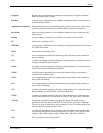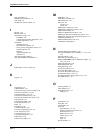
Index
Index-53821-A2-GB20-30 February 1998
Pattern (Test branch), 3-14
Pause Time (for “,” dial modifier), 3-31
pin assignments
EIA–232–E, E-1
JM8 to RJ11 crossover cable, E-2
NIM cable, E-3
primary channel, 6-1
problems
echoing AT commands, C-2
fax operation, C-4
high error rates, C-4
leased line operation, C-2
modem health, C-1
modem will not answer, C-3
modem will not connect, C-3
modem will not dial, C-3
unreadable data, C-2
unsolicited disconnects, C-4
punchdown block, 2-2
punchdown block wiring, E-3
Q
quick configuration display, 3-7
quiet answer, 4-4
R
R (Reverse dial), 4-4
Receive Remote Loopback, 3-44
Record (Status branch), 3-12
recovering use of AT commands, 4-26
remote access (S55), 4-21
Remote Access Password, 3-45, 4-21
Remote branch, 6-1
Remote Digital Loop, 3-14
Remote Mode Indicator, 1-4
remote modem Top-Level menu, 6-2
Repeat Last Command (A/), 4-3
Reset, 3-47
Reset (ATZ), 4-6
Reset Security, 7-8
Result Code Control (ATQ), 4-5
result codes, B-1
enable/disable, 3-27, 4-5
extended, 4-6
format, 3-28, 4-5
Result Codes Format (ATV), 4-5
return to command mode, 4-4
return to Online mode (ATO), 4-4
ring number (S0), 4-16
RJ11 cellular Adapt (S93), 4-25
RJ11 gang box, 2-2
RTS Action (&R), 3-22, 4-10
RTS-to-CTS Delay (S26), 4-18
RTS/CTS Delay, 3-23
RX Buff Disc Delay, 3-43
S
S–registers
changing, 4-5
displaying, 4-5
list of, 4-16
S0 (Auto–Answer Ring Number), 3-30, 4-16
S2 (Escape Character), 3-25, 4-1, 4-16
S3 (Carriage Return Character), 3-26, 4-16
S4 (Line Feed Character), 3-27, 4-17
S5 (Backspace Character), 3-26, 4-17
S6 (Blind Dial Pause), 3-30, 4-17
S7 (No Answer Timeout), 3-31, 4-17
S8 (“,” Pause Time), 3-31, 4-17
S10 (No Carrier Disconnect), 3-32, 4-17
S12 (Escape Guard Time), 3-26, 4-1, 4-17
S14 (Asymmetric Rate Mode), 4-18
S18 (Test Timeout), 3-44, 4-18
S26 (RTS–to–CTS Delay), 3-23, 4-18
S39 (Receive Buffer Disconnect Delay), 3-43, 4-18
S40 (Auto Make Busy), 3-33, 4-18
S41 (Dial Line Rate), 4-19
S43 (Train Time), 3-36, 4-19
S44 (Leased Line Rate), 3-34, 3-37, 4-20
S45 (Leased Line Transmit Level), 3-38, 4-20
S48 (Leased Line Carrier On Level), 3-38, 4-20
S49 (Transmit Buffer Disconnect Delay), 3-43, 4-21
S55 (Access from Remote), 3-45, 4-21
S56–S59 (Remote Access Password), 3-45, 4-21
S62 (V.25bis Coding), 3-28, 4-21
S63 (V.25bis Idle Character), 3-29, 4-22
S64 (V.25bis New Line Character), 3-29, 4-22
S66 (NMS Call Messages), 3-46, 4-22
S69 (Make Busy Via DTR), 3-33, 4-22
S74 (Network Position Identifier), 3-46, 4-22
S75 (Network Management Address), 3-46, 4-22
S76 (Autorate – Dial Line), 3-35, 4-23
S77 (DTR Alarm Reporting), 3-46, 4-23
S78 (Automode), 3-35, 4-23
S80 (No Data Disconnect Trigger Signal), 3-33, 4-23
S82 (Autorate – Leased Line), 3-38, 4-23
S84 (AT Command Mode), 3-28, 4-24
S85 (Fast Disconnect), 3-31, 4-24
S88 (Straps When Disconnected), 3-45, 4-24
S89 (V.42 ARQ Window Size Increase), 4-24
S90 (DTE Rate = VF Rate), 3-24, 4-24
S91 (Cellular Enhancement), 3-43, 4-25
S93 (RJ11 Cellular Adapt), 3-46, 4-25
SDCP (Shared Diagnostic Control Panel)
Hidden Choice Indicators, 1-4
keypad, 1-4
operation, 1-4
using to change factory presets, 2-5
secondary channel, 6-1
security
DTE password, 7-2
VF and DTE, 7-2
VF password, 7-2
VF with DTE, 7-2
Security branch, 7-3
Security configuration options, 7-9
security messages, 3-3
selecting a modem from the DCP, 3-7


















